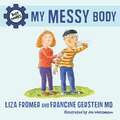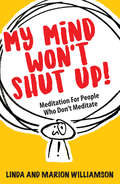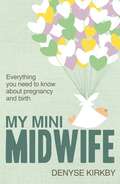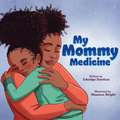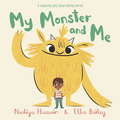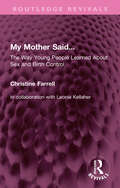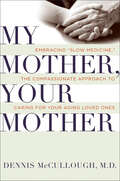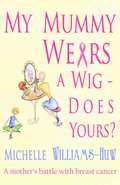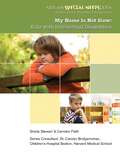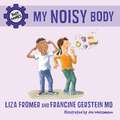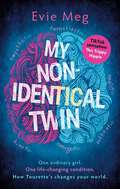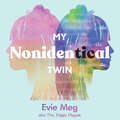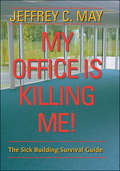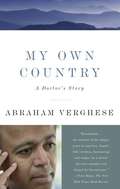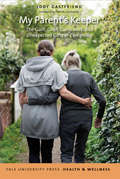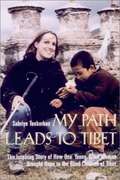- Table View
- List View
My Messy Body (Body Works)
by Liza Fromer Francine GersteinYoung children are full of questions about how their bodies work. With straightforward, easy-to-understand language and a playful attitude, Liza Fromer and Francine Gerstein MD have collaborated to create books packed with solid information about the intricacies of the human body. Their reassuring text describes the body&’s various systems and supplies parents and caregivers with answers that will help them provide the accurate, age-appropriate information young children need. My Messy Body is about the sometimes yucky functions of the body: why are vomit, puss, and snot sometimes good for us? and yes, pee and poo are also on the list!
My Mind Won't Shut Up!: Meditation for People Who Don't Meditate
by Marion Williamson Linda Williamson Sarah RayWarning… this book has not been written by a monk and you don't have to be interested in clean-living, mantras or attaining oneness with the Universe to find it helpful.This is a simple, easy to follow and sometimes funny non-confrontational book on how you can use meditation to help you be aware of the present moment. The more aware you become of your repetitive internal gibberish, the easier it will become to spot unhelpful thoughts, drop them, or replace them with kinder ones. This applies to anyone's mind.What this book is…Everything you need to know about meditation without being too po-faced.Squishes the popular myths and tells you like it is.Shows you how to manage your preposterously messy brain, making you feel a bit happier and more in control.Shows you how to tackle all your wriggly excuses. What this book isn't...A spiritual journey.It will not provide you with a complete guide on how to control your thoughts and feelings – having a chaotic mind is just an annoying part of being human.There's nothing religious in it.It won't make you better at Kung Fu.Written by two sturdy-legged, chip eating meditating sisters from Scotland, My Mind Won't Shut Up is the book they looked for to give to friends, but couldn't find... so they wrote this for you.
My Mini Midwife: Everything You Need to Know about Pregnancy and Birth
by Denyse KirkbyEver wished your midwife lived next door so you could ask her questions anytime? My Mini Midwife, by midwife and lecturer D. J. Kirkby, is here to provide the guidance you need. This handy book gives clear answers to confusing questions, from conception to delivery and beyond: it will be invaluable for anyone who is planning or expecting a baby.
My Mini Midwife: Everything You Need to Know about Pregnancy and Birth
by Denyse KirkbyEver wished your midwife lived next door so you could ask her questions anytime? My Mini Midwife, by midwife and lecturer D. J. Kirkby, is here to provide the guidance you need. This handy book gives clear answers to confusing questions, from conception to delivery and beyond: it will be invaluable for anyone who is planning or expecting a baby.
My Mom, Style Icon
by Piper WeissMoms are people, too...fashionable people! Before we came along to yank on their skirts, they showed leg, sported killer bangs, and flaunted bikinis. Some even wore feathers and halter tops and drove around on motorcycles. Was their style shocking? Yes. Covetable? Absolutely. Based on Piper Weiss's hugely popular blog of the same name, this book features 200 color photographs from decades past of moms showing us how its done. A perfect gift for mothers, daughters, and style mavens, My Mom, Style Icon is an entertaining celebration of the very first—and most important—style icon in a young woman's life.
My Mommy Medicine
by Edwidge DanticatMy Mommy Medicine is a picture book about the comfort and love a mama offers when her child isn't feeling well, from renowned author Edwidge Danticat.Whenever I am sick,Or just feel kind of gloomy or sad,I can always count on my Mommy Medicine.When a child wakes up feeling sick, she is treated to a good dose of Mommy Medicine. Her remedy includes a yummy cup of hot chocolate; a cozy, bubble-filled bath time; and unlimited snuggles and cuddles. Mommy Medicine can heal all woes and make any day the BEST day!Award-winning memoirist Edwidge Danticat's rich and lyrical text envelops the reader in the security of a mother's love, and debut artist Shannon Wright's vibrant art infuses the story with even more warmth.A Parent's Choice Recommended Award Winner 20192020 Bank Street College of Education Best Children's Books of the Year List
My Monster and Me
by Nadiya HussainThe very first picture book from the winner of The Great British Bake Off and national treasure, Nadiya Hussain, beautifully illustrated by Ella Bailey.A touching story about a little boy whose worry monster follows him everywhere he goes. It's there when he gets dressed, when he wants to play with his toys, and even when his friends come over to visit. How can he escape his worries?Having suffered with panic disorder herself for as long as she can remember, Nadiya wrote this heartfelt story to help give children and parents the tools they need to talk about worries and anxiety, to ensure that no child suffers in silence.
My Mother Said...: The Way Young People Learned About Sex and Birth Control (Routledge Revivals)
by Christine FarrellBased on over 1500 interviews with a national random sample of 16- to 19-year-olds in 1974–5, originally published in 1978, My Mother Said… examines the sources of information encountered by young people during their early years which helped or hindered them in their acquisition of knowledge about sex and birth control.The study explores teenage patterns of sexual behaviour and contraceptive practice and looks at the way in which learning and sexual behaviour are related. Interviews were also conducted with over 300 parents of the teenagers, their attitudes to and experiences of the provision of sex-related information being discussed and described in detail. The author’s findings suggest that, although sex education from parents and in schools had improved over the previous ten years, there was still considerable room for changes in attitude and education. By putting the young people’s views and experiences in perspective, the book would help teachers, parents and others concerned to develop sex education along lines which would meet the needs of the young at the time.
My Mother, Your Mother: What to Expect As Parents Age
by Dennis McCullough“[A] geriatrician’s guide to stepping in as escort, caregiver and advocate for your parent’s final journey . . . comforting in its compassion and detail.” —St. Petersburg TimesGeriatrician Dennis McCullough has spent his life helping families to cope with their parents’ aging and eventual final passage, experiences he faced with his own mother. In this comforting and much-needed book, he recommends a new approach, which he terms “Slow Medicine.”Shaped by common sense and kindness, grounded in traditional medicine yet receptive to alternative therapies, Slow Medicine advocates for careful anticipatory “attending” to an elder’s changing needs rather than waiting for crises that force acute medical interventions—an approach that improves the quality of elders’ extended late lives without bankrupting their families financially or emotionally. As Dr. McCullough argues, we need to learn that time and kindness are sometimes more important and humane at these late stages than state-of-the-art medical interventions.My Mother, Your Mother will help you learn how to:Form an early and strong partnership with your parents and siblingsStrategize on connecting with doctors and other care providersNavigate medical crisesCreate a committed Advocacy TeamReach out with greater empathy and awarenessFace the end-of-life time with confidence and skillAlthough taking care of those who have always cared for us is not an easily navigated time of life, My Mother, Your Mother will help you and your family to prepare for this complex journey. This is not a plan for getting ready to die; it is a plan for understanding, for caring, and for helping those you love live well during their final years. And the time to start is now.
My Mother's Keeper: A Daughter's Memoir of Growing Up in the Shadow of Schizophrenia
by Tara Elgin Holley Joe HolleyDawn Elgin was destined to be a 1940s big-band star. From the time she was fourteen, she took her place at the microphone in Houston's elite Empire Room and sang with the voice of a jazz angel. Vibrant and glamorous, she boldly pursued her love of performing to New Orleans, Hollywood, and New York, where she gave birth to her daughter, Tara, when she was twenty-one. Then Dawn began to suffer persistent visions of a deathly specter at her bedside. She was diagnosed with acute paranoid schizophrenia and began a lifetime spent in and out of institutions. My Mother's Keeper is Tara's deeply moving story of growing up in the shadow of her mother's tragic illness. As Dawn's state worsened, Tara lived in the care of her imperious great-great-aunt Elsa - the family's elderly matriarch, who drew her into a rich world of old-fashioned treasures and Houston history - while her mother drifted in and out of Tara's life like a fading fairy princess. Though Tara yearned for her mother during her childhood, Dawn's condition was usually kept from her, the subject of secretive family discussion and neighborhood gossip. By the time Tara was seventeen she had become Dawn's guardian, bent on rescuing the shambling street person her mother had become and transforming her back into the beautiful, lively woman she remembered. Above all, it is a deeply moving exploration of the mother-daughter bond - of how Tara learned to balance her mother's needs with her own, and how she finally came to terms with Dawn's legacy when she became a mother herself. Emotionally compelling and powerfully rendered, My Mother's Keeper offers indelible proof of love's power to transcend a devastating illness.
My Mummy Wears a Wig: Does Yours?
by Michelle Williams-HuwA true and heart warming account of a journey through breast cancer.A diagnosis of breast cancer made Michelle Williams-Huw, mother of two small boys, re-evaluate her life as she battled her demons to come to terms with the illness. My Mummy Wears A Wig is poignant, sad, revelatory and deliciously funny. Readers will be riveted by her honesty and enchanted as, having hit bottom, she falls in love with life (and her husband) all over again.My Mummy Wears A Wig is a moving and humorous account of Michelle’s personal journey, which reveals the fears, the hopes and the absurdity of her situation. With two small children to care for and a life in turmoil, she recounts her day to day struggles while undergoing nine months of treatment. She relates with captivating candour, the effects that the illness has on her relationships with her husband and those around her.
My Mummy Wears a Wig: Does Yours?
by Michelle Williams-HuwA true and heart warming account of a journey through breast cancer.A diagnosis of breast cancer made Michelle Williams-Huw, mother of two small boys, re-evaluate her life as she battled her demons to come to terms with the illness. My Mummy Wears A Wig is poignant, sad, revelatory and deliciously funny. Readers will be riveted by her honesty and enchanted as, having hit bottom, she falls in love with life (and her husband) all over again.My Mummy Wears A Wig is a moving and humorous account of Michelle’s personal journey, which reveals the fears, the hopes and the absurdity of her situation. With two small children to care for and a life in turmoil, she recounts her day to day struggles while undergoing nine months of treatment. She relates with captivating candour, the effects that the illness has on her relationships with her husband and those around her.
My Name Is Not Slow: Kids with Intellectual Disabilities (Kids with Special Needs: IDEA (Individua)
by Sheila StewartKids with intellectual disabilities too often have to put up with teasing and name-calling. Some people don't know how to talk to or interact with people whose brains work differently than their own. Kids with intellectual disabilities might have trouble remembering things or understanding how things work, but there are a lot of things they do understand. Things like friendship, love, and laughter are important to everyone, and that includes kids with intellectual disabilities.
My New Roots
by Sarah BrittonAt long last, Sarah Britton, called the "queen bee of the health blogs" by Bon Appétit, reveals 100 gorgeous, all-new plant-based recipes in her debut cookbook, inspired by her wildly popular blog.Every month, half a million readers--vegetarians, vegans, paleo followers, and gluten-free gourmets alike--flock to Sarah's adaptable and accessible recipes that make powerfully healthy ingredients simply irresistible. My New Roots is the ultimate guide to revitalizing one's health and palate, one delicious recipe at a time: no fad diets or gimmicks here. Whether readers are newcomers to natural foods or are already devotees, they will discover how easy it is to eat healthfully and happily when whole foods and plants are at the center of every plate.From the Hardcover edition.
My New Roots
by Sarah BrittonHolistic nutritionist and highly-regarded blogger Sarah Britton presents a refreshing, straight-forward approach to balancing mind, body, and spirit through a diet made up of whole foods. Sarah Britton's approach to plant-based cuisine is about satisfaction--foods that satiate on a physical, emotional, and spiritual level. Based on her knowledge of nutrition and her love of cooking, Sarah Britton crafts recipes made from organic vegetables, fruits, whole grains, beans, lentils, nuts, and seeds. She explains how a diet based on whole foods allows the body to regulate itself, eliminating the need to count calories. My New Roots draws on the enormous appeal of Sarah Britton's blog, which strikes the perfect balance between healthy and delicious food. She is a "whole food lover," a cook who makes simple accessible plant-based meals that are a pleasure to eat and a joy to make. This book takes its cues from the rhythms of the earth, showcasing 100 seasonal recipes. Sarah simmers thinly sliced celery root until it mimics pasta for Butternut Squash Lasagna, and whips up easy raw chocolate to make homemade chocolate-nut butter candy cups. Her recipes are not about sacrifice, deprivation, or labels--they are about enjoying delicious food that's also good for you.
My Noisy Body (Body Works)
by Liza Fromer Francine GersteinYoung children are full of questions about how their bodies work. With straightforward, easy-to-understand language and a playful attitude, Liza Fromer and Francine Gerstein MD have collaborated to create books packed with solid information about the intricacies of the human body. Their reassuring text describes the body&’s various systems and supplies parents and caregivers with answers that will help them provide the accurate, age-appropriate information young children need. My Noisy Body deals with the digestive system and the many noises it creates, from burps to stomach growls to farts. Why do we hiccup? Sneeze? Snore?
My Nonidentical Twin: What I'd like you to know about living with Tourette's
by Evie Meg Hippie*Order now to be the first to read the debut book from the huge TikTok sensation Evie Meg | This Trippy Hippie!*Hey guys, you might know me already from one of my social media channels where I talk about the highs and lows of living with Tourette's Syndrome. I've loved sharing those times with you and - as there are lots of things I can't fit into a 60 second video - I've decided to write a book! It's the full story of how I came to be diagnosed and how having Tourette's has changed my life. Writing it has given me an opportunity to talk about things I haven't felt ready to share before - for some reason it's easier to put down private things in written words than in a video! I talk about the many other illnesses I've been through and the dreams that it's affected - about my school days, relationships and my very lowest points - but I also talk about what I've managed to achieve in spite of all the obstacles. I hope it'll make you laugh and make you think, and empower you to realise that no matter what you're facing in life, there are always ways to deal with the challenges. It's also so important to me that people understand what life is like with a disability, so we can be compassionate towards each other. I've bared my soul in this book to hopefully help others to do this. I'm so excited (and just a little bit nervous) for you to read it!Evie Meg xxx
My Nonidentical Twin: What I'd like you to know about living with Tourette's from the TikTok sensation This Trippy Hippie
by Evie Meg Hippie*Order now to read the long-awaited debut book from the huge TikTok sensation Evie Meg | This Trippy Hippie!* Hey guys, you might know me already from one of my social media channels where I talk about the highs and lows of living with Tourette's Syndrome. I've loved sharing those times with you and - as there are lots of things I can't fit into a 60 second video - I've decided to write a book! It's the full story of how I came to be diagnosed and how having Tourette's has changed my life. Writing it has given me an opportunity to talk about things I haven't felt ready to share before - for some reason it's easier to put down private things in written words than in a video! I talk about the many other illnesses I've been through and the dreams that it's affected - about my school days, relationships and my very lowest points - but I also talk about what I've managed to achieve in spite of all the obstacles. I hope it'll make you laugh and make you think, and empower you to realise that no matter what you're facing in life, there are always ways to deal with the challenges. It's also so important to me that people understand what life is like with a disability, so we can be compassionate towards each other. I've bared my soul in this book to hopefully help others to do this. I'm so excited (and just a little bit nervous) for you to read it!Evie Meg xxx
My Nonidentical Twin: One ordinary girl. One life-changing condition. How Tourette’s changes your world.
by Evie Meg Hippie*Order now to read the long-awaited debut book from the huge TikTok sensation Evie Meg | This Trippy Hippie!* Hey guys, you might know me already from one of my social media channels where I talk about the highs and lows of living with Tourette's Syndrome. I've loved sharing those times with you and - as there are lots of things I can't fit into a 60 second video - I've decided to write a book! It's the full story of how I came to be diagnosed and how having Tourette's has changed my life. Writing it has given me an opportunity to talk about things I haven't felt ready to share before - for some reason it's easier to put down private things in written words than in a video! I talk about the many other illnesses I've been through and the dreams that it's affected - about my school days, relationships and my very lowest points - but I also talk about what I've managed to achieve in spite of all the obstacles. I hope it'll make you laugh and make you think, and empower you to realise that no matter what you're facing in life, there are always ways to deal with the challenges. It's also so important to me that people understand what life is like with a disability, so we can be compassionate towards each other. I've bared my soul in this book to hopefully help others to do this. I'm so excited (and just a little bit nervous) for you to read it!Evie Meg xxx
My Office Is Killing Me!: The Sick Building Survival Guide
by Jeffrey C. MayBacteria and mold may lurk undetected in carpets or in the heating or cooling system of your office or school. When inhaled, the by-products of these organisms can cause allergy and asthma symptoms. Chemical vapors emitted by office furniture and equipment may also foul the air we breathe indoors, causing headaches, eye irritation, or other symptoms. Here the author of the best-selling My House Is Killing Me! and co-author of The Mold Survival Guide turns his attention to indoor air quality in public buildings. Blending his extensive professional experience with scientific explanations, May helps us see these buildings through the eyes of a building scientist, microscopist, and organic chemist. He offers a step-by-step approach to identifying, controlling, and often eliminating the sources of indoor air pollutants and allergens. Whether it's a case of mold in an elementary school or inadequate ventilation in a high-rise office building, this valuable guide can help people cope when the air they breathe indoors is making them sick.
My Own Country: A Doctor's Story
by Abraham Verghese<p>Nestled in the Smoky Mountains of eastern Tennessee, the town of Johnson City had always seemed exempt from the anxieties of modern American life. But when the local hospital treated its first AIDS patient, a crisis that had once seemed an urban problem, had arrived in the town to stay. <p>Working in Johnson City was Abraham Verghese, a young Indian doctor specializing in infectious diseases. Dr. Verghese became by necessity the local AIDS expert, soon besieged by a shocking number of male and female patients whose stories came to occupy his mind, and even take over his life. <p>Verghese brought a singular perspective to Johnson City: as a doctor unique in his abilities; as an outsider who could talk to people suspicious of local practitioners; above all, as a writer of grace and compassion who saw that what was happening in this conservative community was both a medical and a spiritual emergency. Out of his experience comes a startling but ultimately uplifting portrait of the American heartland as it confronts--and surmounts--its deepest prejudices and fears.</p>
My Paleo Patisserie
by Jenni HuletMy Paleo Patisserie gathers all the rich heritage, exquisite elegance, and rustic beauty of traditional patisserie baking and seamlessly melds it with the gluten-free and Paleo-inspired diet. Drawing on over two decades of experience in traditional and modern patisserie baking, Jenni Hulet brings the spirit of patisserie baking alive in this lavishly photographed collection of recipes. Each section of My Paleo Patisserie introduces and adapts the fundamental elements and techniques of traditional patisserie baking for the grain-free baker. With dozens of beloved culinary standards and hundreds of potential recipe combinations, My Paleo Patisserie is an indispensable resource of creative grain-free confectionery.
My Parent's Keeper: The Guilt, Grief, Guesswork, and Unexpected Gifts of Caregiving (Yale University Press Health & Wellness)
by Jody Gastfriend&“Unflinchingly tackles a complex aspect of eldercare in each chapter . . . an indispensable resource for family caregivers.&”—Patrick O&’Malley, author of Getting Grief Right When it comes time to provide care for those who once cared for us, where can we turn? This book offers practical guidance for a broad range of caregiving situations when family caregivers assume their new role. My Parent&’s Keeper . . . · Uses the latest research and draws on case histories and interviews. · Is a resource as well as a source of inspiration, with a blend of powerful stories and practical advice. · Helps caregivers cope with numerous challenges, including parents who need but refuse help; siblings who don&’t get along; the complexity of healthcare systems; financial issues; juggling work and caregiving; the use of technology; the power of connecting with a loved one who has dementia; and realizing the benefits amid the burdens of caregiving. &“Jody Gastfriend has created the ultimate GPS for family caregivers. At once humane and helpful, personal and political, she charts the long, hard, and rewarding role that all of us will take caring for our families and each other. Don&’t leave home without it!&”—Ellen Goodman, Pulitzer Prize-winning columnist and founder of The Conversation Project &“My Parent's Keeper shines a light on the conundrum of caregiving—as adult children, our best intentions are insufficient to help our parents and ourselves. We need a plan in advance of need—this book offers up-to-date guideposts for this inevitable caregiving journey.&”—Laurie M. Orlov, author of When Your Parents Need Elder Care: Lessons from the Front Lines
My Path Leads to Tibet: The Inspiring Story of How One Young Blind Woman Brought Hope to the Blind Children of Tibet
by Sabriye TenberkenDefying everyone's advice, armed only with her rudimentary knowledge of Chinese and Tibetan, Sabriye Tenberken set out to do something about the appalling condition of the Tibetan blind, who she learned had been abandoned by society and left to die. Traveling on horseback throughout the country, she sought them out, devised a Braille alphabet in Tibetan, equipped her charges with canes for the first time, and set up a school for the blind. Her efforts were crowned with such success that hundreds of young blind Tibetans, instilled with a newfound pride and an education, have now become self-supporting. A tale that will leave no reader unmoved, it demonstrates anew the power of the positive spirit to overcome the most daunting odds.
My Period: Find your flow and feel proud of your period!
by Milli HillThe one stop guide to getting your period. Getting your first period can be exciting - but there are a lot of questions you might be too embarrassed to ask. Like how much will I bleed? Does it hurt? How can I prepare? And what's the point of a period anyway?Separating the fact from the fiction, Milli Hill answers everything you need to know - from menstrual cups and period pants, to cramps and hormones. She'll explain how incredible your body is, what is actually going on each month and why. With guidance on choosing period products, charting your cycles and preparing a first period kit, alongside profiles of 'cycle superstars', such as Amika George, who are working to end period poverty and start open conversations around periods, this book is the complete guide to getting your period.So find your flow, bust some myths and start to feel proud of your monthly cycle and your truly amazing body!
